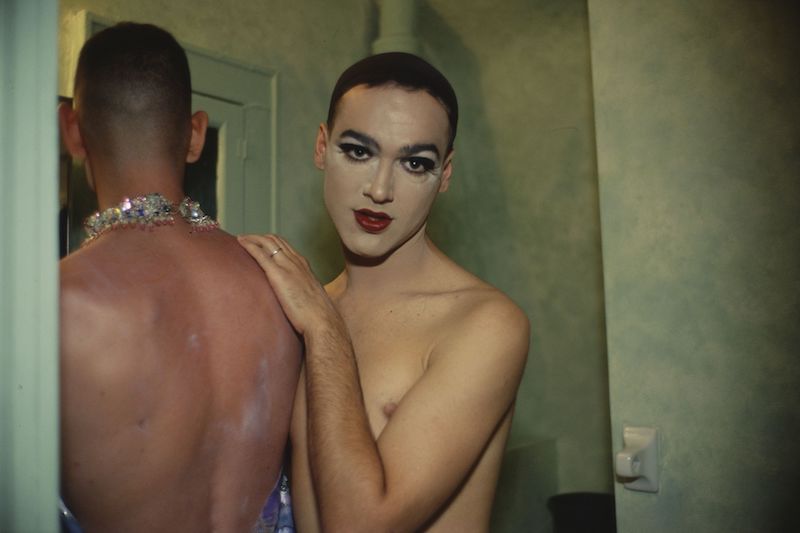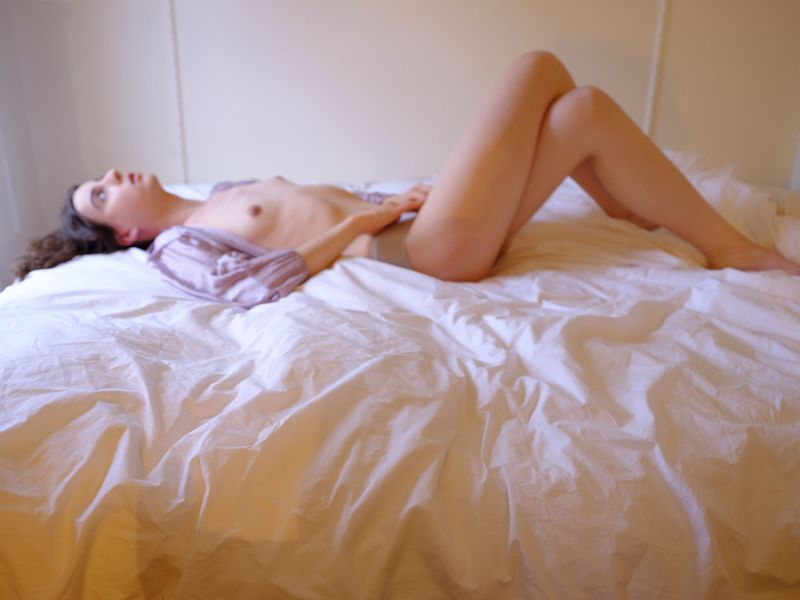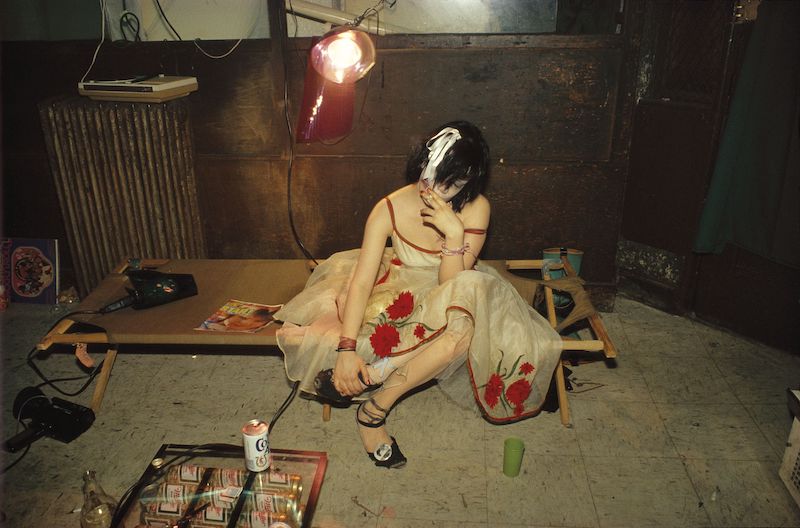by Annalisa Giacinti // Feb. 21, 2023
This article is part of our feature topic Family.
There is something very calming about Nan Goldin’s photographs, a sort of comfortable intimacy that’s easy to witness and stand in front of. The subjects photographed don’t appear impatient, nor intruded upon, the camera doesn’t assert its presence, life depicted is unedited, unaltered, and requires no explanatory caption. This quiet realm is currently being displayed at Akademie der Künste in Berlin, which is hosting a major retrospective that spans Goldin’s work of five decades, from the early 1970s until 2020, including the early days of the pandemic. The exhibition coincides with the 2022 Käthe Kollwitz award ceremony, during which the American photographer will be accepting the prestigious prize honouring her contribution to contemporary photography, and her enduring and committed allegiance to the LGBTQ+ community. Her work, elucidate the curators in charge, “has broken taboos and transcended boundaries,” and most importantly has advocated for the rights of trans people, drag queens and those living at the margins of gender conformity who, more than 50 years ago, were being ostracised by society and lived “on the other side” of it.

Nan Goldin: ‘Jimmy Paulette and Tabboo! in the Bathroom,’ 1991, Cibachrome print, 72,6 x 101,6 cm // Photo by Nan Goldin, courtesy of the artist and Marian Goodman Gallery
At AdK, the images are distributed across two dark gallery rooms, arranged non-chronologically and backlit against a black wall that provides no additional text. The exhibition features both black-and-white and colour photographs, as well as portraits from Goldin’s most iconic series and large-scale landscapes from her more recent works. The sequence begins with a portrait of her friend and roommate, writer Thora Siemsen, lying on her white bed in her Brooklyn apartment and caught in a pensive mood amidst the hush of quarantine. The picture is shown alongside early photos from the artist’s years in Boston, of her roommate applying makeup, sitting on a chair, or her friends stepping out into the night. The intimate and domestic settings of these initial photos seem to set the tone for the general atmosphere at the gallery, which is private and suggestive of a comforting presence that is her camera’s loving embrace. “It’s very intimate for me to photograph someone,” recalls Goldin during a talk with Siemsen in 2021. “I need to feel a deep connection, and that can become deeper through the process. When I see somebody who’s beautiful and doesn’t know it, I feel an obligation to show them to themselves.”

Nan Goldin: ‘Thora on my white bed, Brooklyn, NY,’ 2020, Archival pigment print, 76.2 x 102 cm // Photo by Nan Goldin, courtesy of the artist and Marian Goodman Gallery
Pictures of queer and trans communities in the 1990s and 2000s follow: taxi rides, drag shows and backstage rituals between sets across the bathrooms and dressing rooms of New York, Berlin, Manila and Bangkok. There are also works from ‘The Ballad of Sexual Dependency,’ a series originally conceived in 1983 as a slideshow accompanied by music shown at nightclubs and underground cinemas around the city, and gradually grown into a seminal and pioneering project. One that Goldin continued to edit and expand ever since, consistently adding imprints and records of her own “extended family.”
Though manipulable, memory is something Goldin has always been obsessed with, she admits in many interviews, stressing convincingly the affirming and preserving potential of photography. “What I see has been here, in this place which extends between infinity and the subject […] it has been absolutely, irrefutably present,” wrote Roland Barthes in ‘Camera Lucida’ (1980), a statement acted out by Goldin with every picture shot. Her tribe, her community—her family—did exist; her camera captured their indelible presence, and her work became a natural offshoot of her life. “I used to think I could never lose anyone if I photographed them enough,” the artist says in the 1995 documentary ‘I’ll Be Your Mirror.’ She photographed her friends obsessively, even when AIDS began to claim their lives in the 1980s. “I confronted reality as I watched a number of my friends die.” Nevertheless, she dedicated her whole life to try and never lose the memory of anyone again.

Nan Goldin: ‘Trixie on the cot, New York City,’ 1979, Cibachrome print, 41 x 60 cm // Photo by Nan Goldin, courtesy of the artist and Marian Goodman Gallery
Not only friendship, but love, pleasure, violence and pain intertwine in the epic work of ‘The Ballad of Sexual Dependency.’ Young lovers kiss and embrace and make love on tangled beds, bodies lie on top and against each other on the hot beach of New York’s Fire Island. Goldin curls up in bed gazing at her abusive lover Brian in a well-known self-portrait, Lower East Side socialite Cookie Mueller attends her husband’s casket, and in another she sits down on her bed, her eyes dulled by illness and grief. Nan Goldin captured it all—desire and heartache, passion and devastation, the euphoria and decadence of drug-consumption and addiction, the extremes of life and all the nuances in between—with curiosity, acceptance, respect but never voyeurism; with an unwavering empathy that met all of her subjects’ receptive trust. “Somebody I used to photograph constantly said it was no different from drinking a cup of coffee with me. I mean it became an extension of me, the camera,” she says in another interview. “I never photograph out of hate. And I don’t think I’ve ever taken a mean picture intentionally in my life.”

Nan Goldin: ‘Blue Hills, Italy,’ Archival pigment print, 76.2 x 114.3 cm // Photo by Nan Goldin, courtesy of the Artist and Marian Goodman Gallery
While most of the images on view at AdK were shot indoors, contributing to the warm and almost cosy ambiance of the space, the exhibition includes few large-scale works such as landscapes, grids and stills from the series ‘Memory Lost.’ A recurrent motif, memory, here explored and conveyed as an experience altered and lost through drug addiction. With most of her beloved friends now gone, the artist is less and less keen on photographing people and for the first time she has turned to nature and the sky. “I care enormously about light now,” she acknowledges. After running away from her home in suburban Boston following her sister’s suicide, Goldin picked up her first polaroid camera at the age of 15, and began taking photos of her best friends. The camera gave her a voice, and an “entrée into human contact.” Since then, she has used it to connect with the people she loved, and to keep their voices alive too. Ultimately, photography doesn’t save lives, but “it makes bearable things that feel unbearable”—which is close to what family, of any sort and nature, does.
Exhibition Info
Akademie der Künste
‘Käthe-Kollwitz-Preis 2022. Nan Goldin’
Award Ceremony: Mar. 03, 2023; 8pm
Exhibition: Jan. 20–Mar. 19; 2023
www.adk.de
Hanseatenweg 10, 10557 Berlin, click here for map























